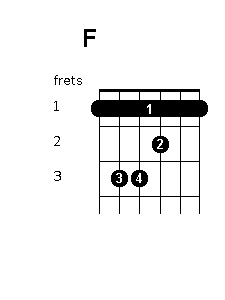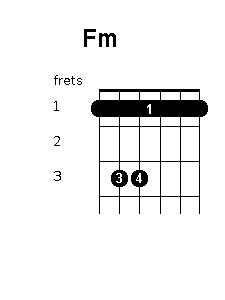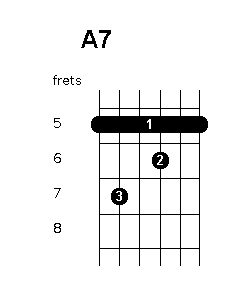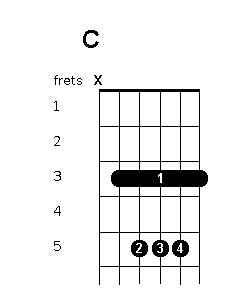The Bar chords are chords that involve using one finger, usually your first finger, to press all the strings down at once on a single fret. Barring turns your first finger into a movable capo. And it said to be the simplest way to make most standard chords.
Playing the bar is not an easy thing to do at first and usually needs a certain amount of practice. Once you are able to play them, though, bar chords are incredibly useful. The beauty is that when you can play a particular bar chord shape you can move it to any point along the fret board to produce the same type of chord at different pitches.
Practise how to bar:
This should be done very slowly, make sure you stop holding each position after the 5th count. Starting from the thinnest string you are going to barre each string, count to 5, then add another one and repeat. Here is an example:
- Step 1: Bar the thinnest string with the index finger, hold and count 5.
- Step 2: Bar the thinnest string plus the second thinnest string with the index finger and hold for 5 counts.
- Step 3: Bar the 4 thinnest strings with the index finger and hold and count.











There are a few common bar chord shapes that, once mastered, will lend a great amount of versatility to your playing.
This shape is often referred to as an ‘E shape’ bar chord. You’ll notice that the fingering pattern on frets 2 and 3 of this F chord are the same as frets 1 and 2 of an open E chord (with different fingers.) So the whole shape has been moved up one fret and the first finger is used to bar the 1st fret,
The same principal applies here except this is an Em shape. It’s been moved up one fret with the first finger now barring the strings on the 1st fret. Again this can be played at any fret position along the neck and will take it’s name from the root note played on the 6th string eg. at the 3rd fret this would be Gm.
The same idea again here. This chord is shown barred at the 5th fret just to demonstrate the point of movability, taking the shape of the open E7 chord and shifting it up the neck. At the 5th fret the 6th string produces an A note, hence the chord in this example is an A7.
A m7 bar chord shape is the same as this but without the 2nd finger being applied to the fretboard.
A m7 bar chord shape is the same as this but without the 2nd finger being applied to the fretboard.
This bar chord takes it’s shape from an open A chord and so, as you may expect, is commonly referred to as an ‘A shape’ bar chord. The example shown here is a C chord as the root note in this shape is played on the 5th string (A) which produces a C note at the 3rd fret. The shapes of the open Am, A7, Am7 and Amaj7 can all be played as bar chords at any fret on the neck to give these types of chords at different pitches. Note that the 6th string (low E) is not usually sounded when playing this shape of bar chord.












.jpg)

1 comment :
Best chart
Post a Comment